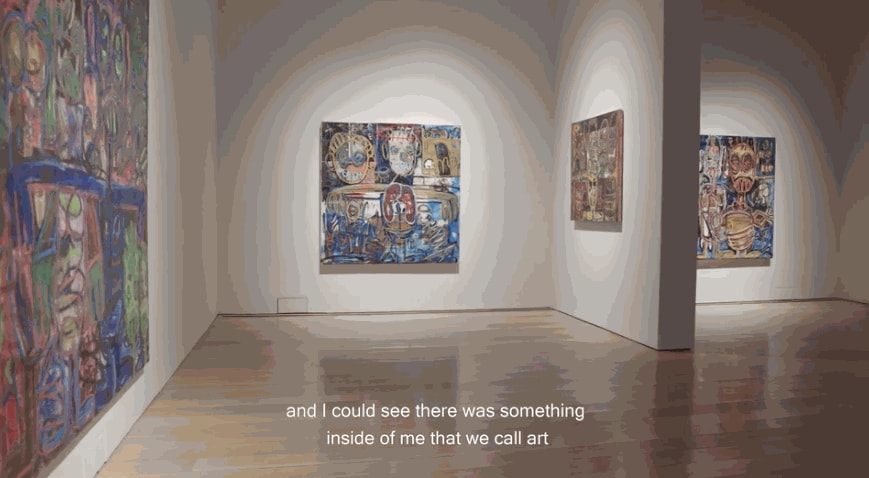
The news stayed a bit under the radar during this global pandemic, but something rather extraordinary happened in the art market earlier this month : the acclaimed Ivorian artist Abdoulaye Diarrassouba (1983), better known under his moniker Aboudia, was given a dedicated online sale at Christie’s New York of paintings and works on paper created by the artist over the past year – you can learn more about this sale here. The auction was accompanied by a solo exhibition of the works on sale in Christie’s Rockefeller Center galleries from 4 to 8 March (as illustrated above).
Not only was it exceptional for an auction house to consign works directly from an artist, the 22 works in the sale all were sold, and the auction made a total of $ 1,066,875 (!), with most works on canvas selling for 10 times the low estimate. Admittedly, the estimates were deliberately kept low – their market value being substantially higher – yet with the six bigger paintings all selling above $100K, all previous price records for the artist were pulverised. In the art industry, that sort of thing should make you famous overnight – yet I have not found many articles about these astonishing results?! For market insiders, this success wasn’t a real surprise, as on October 22th, 2020, the artist’s Le Petit Chien Rouge (2018), which was expected to sell at Sotheby’s for just $23,400, instead was hammered down for $98,400.

Aboudia (1983) – La renaissance du Christ (2020) – 147.6 x 149.9 cm. Estimate $12-15K, sold for $187,500. Image courtesy of Christie’s
Based in both Abidjan and Brooklyn, Aboudia’s work is informed by both Western and African art movements, referencing styles from avant-garde movements such as abstract expressionism to the street art and murals of Abidjan. His paintings consist of layered child-like figures, and often incorporate clippings from newspapers, magazines, or books to contextualise the work. Combining text with raw images, Aboudia has often been compared to Jean-Michel Basquiat, and one can only admit the works do have a comparable energy to them. Depending to who you are talking with, this comparison has worked both against the artist as to his advantage. Personally, I think one is degrading Aboudia’s own unique voice by using the Basquiat reference in sale pitches of his work. The artist himself claims a multitude of both Western and African influences, and the art dealer Jack Bell has recounted how during his initial visits to the Tate Modern, Aboudia was impressed by the large formats used by Jackson Pollock and the loose gestures of Cy Twombly. Anyhow, I think it should be avoided to view his work solely through a western art historical perspective.
Aboudia originally gained international attention in 2011 for his depictions of the Ivorian war and its child soldiers – and that series by some is still considered to be his best work. The artist’s motivation to create art mainly comes from telling stories about the unfavourable conditions and city life of his country, especially for children. You might enjoy to learn he has also been adding photos of classical African masks and statues in his works – for example, spot the Dan masks and Igbo masks in the painting above. Aboudia has stated that these elements of ‘his ancestral history’ nourish him as much as a the raw contemporaneity of city life in Abidjan.
In response to market demand, Aboudia has become a very prolific and productive artist, and has been exhibited by Jack Bell Gallery, Galerie Cécile Fakhoury, Ethan Cohen Gallery, and Saatchi Gallery, among others. The fact that both Jean Pigozzi and Charles Saatchi, two discerning collectors of African art, acquired works from him has counted as an early market validation, and ambitious dealers (and now also auction houses) have been most active to build on to his success. In 2017, Christophe Person (now at Artcurial), for example also held a selling exhibition of Aboudia’s work at the French auction house Piasa. Surely, the Christie’s auction, held in anything but favourable circumstances, also rode the waves of the huge current interest in artworks created by millennial African artists.